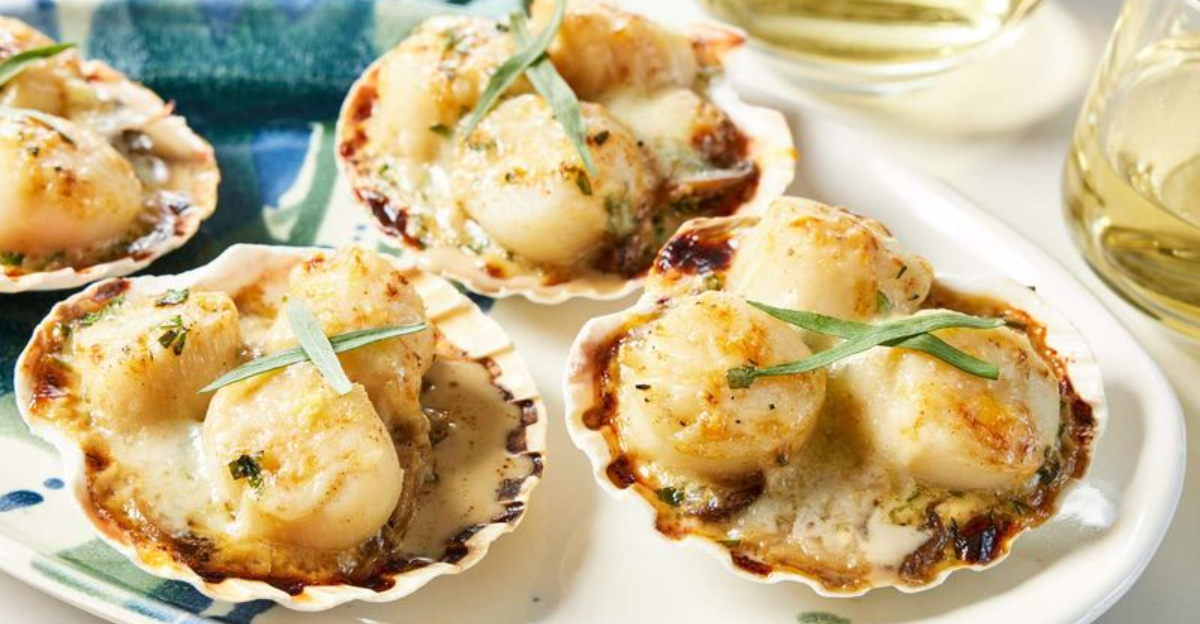11 Retro Seafood Dishes That Vanished From The Menu

Remember those seafood dishes your grandparents raved about that you can’t find anymore? Restaurants once showcased elaborate seafood creations that have slowly disappeared from modern menus.
These vintage ocean delicacies were popular staples at dinner parties and fancy restaurants throughout the mid-20th century.
Join me on a nostalgic journey through 11 retro seafood dishes that have mysteriously vanished from today’s dining scene.
1. Jellied Eel
Chunks of chopped eels boiled in a spiced stock that cooled to form a savory jelly. Popular in London’s East End during the 1950s, this dish was sold from street carts and seafood shops as a quick, protein-rich meal.
My grandfather often told stories of buying jellied eels from vendors along the Thames after long shifts at the dockyard.
The gelatinous texture and strong flavor have fallen out of favor with modern palates, but it was once considered a working-class delicacy.
2. Lobster Thermidor
Once the pinnacle of fine dining, this decadent French creation featured lobster meat cooked in egg yolks, brandy, and mustard, then returned to its shell and browned. The dish was named after a popular 1894 play and became synonymous with luxury dining.
Few restaurants today offer this labor-intensive classic due to changing tastes and its reputation as overly rich. The complexity of preparation and high cost of ingredients have relegated it to specialty menus and historical cookbooks.
3. Oysters Rockefeller
Created in 1899 at Antoine’s Restaurant in New Orleans, this rich appetizer featured oysters topped with a mixture of herbs, bread crumbs, and butter, then baked or broiled. The dish was named after John D. Rockefeller because the sauce was so rich.
When I was a child, my aunt would prepare these for special occasions, carefully selecting each oyster and keeping her sauce recipe a closely guarded secret.
While still found occasionally, the labor-intensive preparation and changing oyster consumption habits have made authentic versions rare.
4. Shrimp Wiggle
A creamy comfort food from the 1930s-50s consisting of shrimp and peas in a white sauce, often served over toast points or in pastry shells. This simple yet satisfying dish appeared in many mid-century cookbooks and women’s magazines.
The humble Shrimp Wiggle was a staple at bridge luncheons and ladies’ gatherings. Its decline coincided with the shift away from cream-based sauces in American cuisine, though variations occasionally appear in retro cookbooks and nostalgic food blogs.
5. Coquilles St. Jacques à la Parisienne
Scallops poached in white wine, placed in their shells with mushrooms and covered with a rich sauce, then topped with cheese and browned. This French classic was a dinner party showstopper throughout the 1960s and 70s.
The presentation in real scallop shells made this dish particularly impressive. Growing up, my mother would save scallop shells all year just to make this dish for Christmas Eve dinner.
Modern restaurants rarely serve it now, favoring simpler preparations that showcase the scallops’ natural flavor.
6. Seafood Aspic
Shrimp, crabmeat, or lobster suspended in savory gelatin, often molded into decorative shapes for mid-century dinner parties. Aspics were considered the height of sophistication in the 1950s and early 60s.
Vintage women’s magazines featured colorful photos of these wobbly creations. The preparation required patience as layers set in the refrigerator.
Modern diners have largely rejected savory gelatins, finding the texture unappealing compared to fresh seafood preparations.
7. Tuna Noodle Casserole With Potato Chips
A quintessential American comfort food combining canned tuna, egg noodles, cream of mushroom soup, and crushed potato chips on top. This budget-friendly dish graced countless dinner tables in the 1950s-70s.
I still remember the sound of my grandmother crushing potato chips in a paper bag to create the perfect topping.
While home cooks might still prepare simplified versions, restaurants abandoned this humble casserole as dining trends shifted toward fresher ingredients and less processed foods.
8. Clams Casino
Littleneck clams on the half-shell topped with a mixture of bell peppers, bacon, garlic, and breadcrumbs, then baked. Created in 1917 at the Casino at Narragansett Pier in Rhode Island, this appetizer was a mainstay on upscale restaurant menus for decades.
The combination of smoky bacon and briny clams made this dish irresistible at cocktail parties. My first job as a teenager was preparing these at a seaside restaurant.
While occasionally found on traditional steakhouse menus, modern chefs have largely moved away from this classic preparation.
9. Sole Véronique
Delicate fillets of sole poached in white wine, covered with a creamy sauce, and garnished with peeled green grapes. This elegant French creation was a staple of fine dining establishments in the mid-20th century.
The unusual combination of fish and fruit made this dish distinctive. Named after the opera ‘Véronique,’ it represented the height of culinary sophistication.
Modern restaurants rarely feature this labor-intensive classic, preferring simpler preparations that highlight the fish’s natural flavor.
10. Creamed Codfish on Toast
Flaked salt cod mixed with a thick white sauce, often incorporating hard-boiled eggs, and served over toast points. This humble dish was a Friday night staple in Catholic households and appeared on diner menus throughout the early to mid-1900s.
Salt cod required soaking overnight to remove excess salt before cooking. The resulting dish provided affordable protein during times when fresh seafood wasn’t widely available.
As refrigeration improved and tastes evolved, this simple preparation faded from home kitchens and restaurant menus alike.
11. Oyster Stew
A simple yet luxurious soup of oysters gently poached in milk or cream with butter and seasonings. This Christmas Eve tradition was particularly popular in coastal and Midwestern American homes from the 1800s through the 1960s.
The delicate flavor depended entirely on the freshness of the oysters and richness of the dairy. Families would gather around steaming bowls on winter evenings, often serving it with oyster crackers.
Modern concerns about raw shellfish consumption and changing holiday traditions have made this once-common dish increasingly rare.
